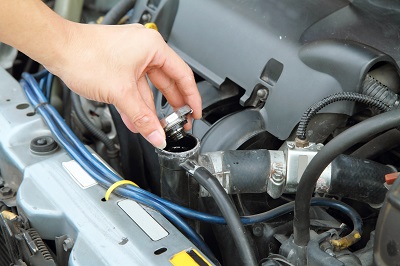Your radiator is one of the engine’s unsung heroes. It’s responsible for essential heat exchange functions in your car’s cooling system. Working in tandem with the thermostat and water pump, the thermostat plays an important role in distributing coolant and also maintaining coolant temperature.
And when the radiator doesn’t work, things heat up in a hurry. The normal operating temperature of the average car engine is around 190-210 degrees Fahrenheit. With a defective radiator, the increased heat starts to wear on other engine components – gaskets, hoses, water pumps and thermostats, just to name a few – and the resulting stress can shorten engine life dramatically.
Thus, it’s a good idea to know how to recognize the most common radiator issues. This will not only help you diagnose problems immediately, but you’ll also know how to avoid the problems in the first place.

The Radiator's Role in the Cooling System
Before looking at some different radiator problems, it helps to know exactly what role the radiator plays in the first place. In order to keep the internal engine temperature at a manageable level, coolant fluid flows around the engine block. When the temperature exceeds a certain point, the thermostat opens up, allowing coolant to flow into the radiator through an upper entry tube. A fan helps reduce the temperature of the coolant, and the fluid goes back into the engine through a lower exit tube. The process repeats constantly, keeping your engine’s temperature range around 190-210 degrees.
Heat, Stress, Cracked Hoses and More
The daily grind of your radiator isn’t an envious one. Unlike your windshield washer fluid system, the coolant system is absolutely critical to keeping the engine running. Given the tremendous heat swings, temperature spikes, pressure buildup and more, it’s not surprising that the radiator is subject to more potential pitfalls than practically every other engine part.
Many things can go wrong, but it’s mostly comprised of a handful of issues. Let’s look at five different radiator problems, and then we’ll review the best ways to avoid them altogether.
1. Rust
Don’t think of rust as something that just affects your car’s body. Oxidation happens everywhere, especially with those engine parts that deal with constant liquid flow. A rusty radiator will soon overheat, causing major engine headaches. Aside from its exterior appearance, you can also check for interior rust as well – if you see a brownish color in the coolant, that means the radiator is rusting from the inside. If enough rust spreads over the radiator (typically in the lower end, but it can also surface elsewhere), small holes will develop. Those small holes will turn into larger holes. The rust problem, as you’d expect, impacts automobiles in harsher climates (cold winters, snow, ice, etc.) at a much higher rate than other cars.
2. Leaks
We’ve listed it #2 here, but it might just be the #1 widespread radiator issue. Due to that extreme pressure buildup we talked about previously, the rubber hoses which connect the radiator to your engine will fail eventually. Plus, the metal hose clamps can also rust or loosen. Whenever hoses start to fail, leaks aren’t far behind. If your car has a sticky, slightly sweet-smelling green fluid on the ground, that’s an indication you’ve sprung a radiator leak. But hoses aren’t the only reason for leaks; radiator body rust is also another common cause of system leaks.
[Related Article: What is leaking from my car?]
3. Overheating
Problem #3 is actually an accumulation of many other problems. A radiator doesn’t just overheat for any good reason; underlying issues contribute to this major problem. Regardless, whenever your car’s engine temperature gauge spikes and you’ve entered the danger zone, pull over and check the coolant overflow tank. A small leak, a loose hose, low coolant level – the causes of overheating are numerous, but you shouldn’t drive with a hot engine. Also, keep in mind that overheating doesn’t necessarily indicate a radiator issue. The thermostat could be stuck, or the water pump may be bad.
4. Mineral Deposits (Gunk)
Gunk? It’s everywhere, even in the radiator. Technically, the mineral deposits that accumulate in your radiator can, over time, cause the component to fail. Once enough of those mineral by-products and deposits collect in your radiator, the restricted coolant flow makes it harder for your radiator to distribute coolant. This is an extremely frustrating radiator problem, especially for those components which appear to be functioning normally. If your radiator has no rust and no obvious defects with hoses or clamps, internal buildup could be the reason your car is overheating.
5. The Domino Effect(s)
Because the radiator, water pump and thermostat have such an interconnected dynamic in the coolant system, it’s only a matter of time before failure in one component spells failure for another. As we touched on in point #3, a faulty thermostat or water pump will certainly impact radiator performance.
A Three-Step Plan to Avoid Radiator Issues
So there you go – the five most common radiator problems. In some ways, all five are interconnected – that is to say, they’re related in some fashion. Do the following three things and you’ll give your radiator the best chance for problem-free performance:
Flush the coolant every 20,000 miles
This will prevent rust and also minimize mineral deposit buildup.
Check your hoses and clamps on a regular basis
A crack, loose clamp, small hole or other problem should be addressed immediately.
Get on a regular coolant check schedule
Every week or so, ensure your radiator coolant level is full. If necessary, add extra coolant to the overflow tank. And keep tabs on your engine temperature gauge while driving.
Even with the best maintenance plan, you’ll need a new radiator at some point. Browse our extensive selection of radiators, or feel free to call one of our radiator specialists at (888) 907-7225 if you can’t find what you’re looking for.


